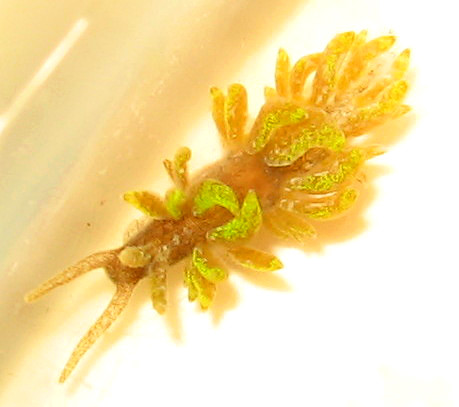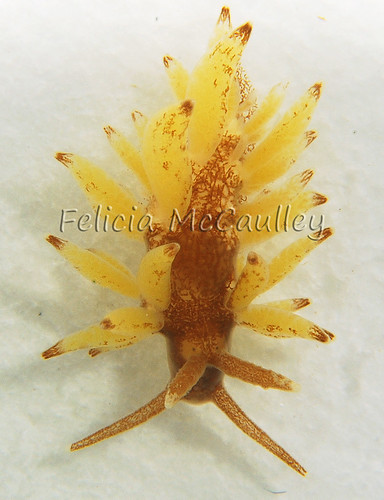I found this Zoanthid eating nudibranch my friend's tank the other day along with the Turbinaria eating slug pictured last. I also found a Blue Eyed Crab eating his Pocillopora. If you ever find a hitchhiker in your aquarium, and you're not sure what it is, feel free to send me a photo or the animal if you can catch it.
Anatomy of a Nudibranch
Zoa eating nudibranchs are a type of Aeolid nudibranch. Notice the black specks behind the first two "antennae?" Those are the eyes. The finger-like appendages on the back are called cerata. The dark tips of the cerata are called cnidosacs. A Zoa eating nudibranch can consume immature nematocysts from its prey and store them in these sacs for protection against predators. The nudibranch gets its coloration from its prey, and may also be photosynthetic.
Most reefers kill the nudibranchs to save their Zoanthus colonies. Beauty is in the eye of the beholder, I suppose, as some people culture the nudibranch and feed it Zoanthids!
Reefers have had success eradicating the Zoa eating nudibranch with Salifert's Flatworm Exit in high doses. Obviously, you have to be careful using this method. It's best to take affected colonies out of the tank and treat them in a bucket of tank water with an overdose of Flatworm Exit. If you have a lot of hidden planaria (which release toxins when they die) in your main tank, it could crash. Have several pounds of carbon on hand when using Flatworm Exit. Since Flatworm Exit won't kill the eggs of the nudibranch, you need to repeat the treatment four days later.
http://www.practicalcoralfarming.com/zoonudis.html

This is only the second Turbinaria eating slug I've ever seen. Removal is not difficult since they are relatively large and don't seem to reproduce in captivity. Both specimens were found on Turbinaria peltata, the Pagoda Cup Coral.

 |
| a Zoanthid eating Nudibranch minus some cerata lost in transit |
Anatomy of a Nudibranch
Zoa eating nudibranchs are a type of Aeolid nudibranch. Notice the black specks behind the first two "antennae?" Those are the eyes. The finger-like appendages on the back are called cerata. The dark tips of the cerata are called cnidosacs. A Zoa eating nudibranch can consume immature nematocysts from its prey and store them in these sacs for protection against predators. The nudibranch gets its coloration from its prey, and may also be photosynthetic.
Most reefers kill the nudibranchs to save their Zoanthus colonies. Beauty is in the eye of the beholder, I suppose, as some people culture the nudibranch and feed it Zoanthids!
Reefers have had success eradicating the Zoa eating nudibranch with Salifert's Flatworm Exit in high doses. Obviously, you have to be careful using this method. It's best to take affected colonies out of the tank and treat them in a bucket of tank water with an overdose of Flatworm Exit. If you have a lot of hidden planaria (which release toxins when they die) in your main tank, it could crash. Have several pounds of carbon on hand when using Flatworm Exit. Since Flatworm Exit won't kill the eggs of the nudibranch, you need to repeat the treatment four days later.
http://www.practicalcoralfarming.com/zoonudis.html

This is only the second Turbinaria eating slug I've ever seen. Removal is not difficult since they are relatively large and don't seem to reproduce in captivity. Both specimens were found on Turbinaria peltata, the Pagoda Cup Coral.


No comments:
Post a Comment